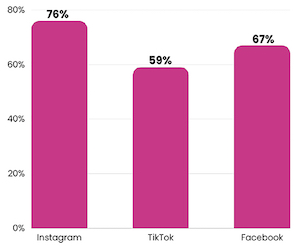Despite all the speculation we’ve heard surrounding influencer marketing’s supposed forthcoming demise, the influencer landscape continues to expand, with marketing in this sector becoming a higher priority in brands’ marketing budgets, according to new research conducted by marketing company Open Influence.
The survey, which sought to uncover what’s shaping brands’ current influencer marketing strategies and where the industry is going, found that nearly two-thirds (64 percent) of brand marketing leaders surveyed expect their influencer budgets to grow this year.
 The most used platforms for influencer marketing. The most used platforms for influencer marketing. |
In fact, 13 percent of brand marketing leaders polled said their brands plan to allocate at least $1 million to influencer campaigns in 2023. More than a quarter (28 percent) said they’ll spend between $250,000 and $1 million, and more than a third (36 percent) said they’ll spend between $50,000-250,000 on influencer marketing. Fewer than a quarter (23 percent) reported influencer expenditures of $50,000 or less for 2023.
An overwhelming majority of brands’ influencer campaigns are still being coordinated through an agency: the report found that 81 percent of brand managers handle their influencer marketing partially or fully with an influencer agency. Only 19 percent manage their influencer campaigns completely in-house.
When it comes to what factors make brands sign the dotted line on an influencer partnership, most (49 percent) still say an influencer’s follower count is their top determination in choosing an influencer, followed by their engagement rate (47 percent), the influencer’s audience demographic (45 percent) and the quality of the content they post (41 percent). Impression rates bottomed out the list, at 34 percent.
According to the survey, most brand leaders (77 percent) said they want long-term relationships with influencers, as opposed to one-off campaigns.
Instagram, the original hub for modern-day influencer marketing, remains the top platform for brands (76 percent), followed by Facebook (67 percent) and TikTok (59 percent), though that short-form video platform has made massive year-over-year gains among the influencer contingent.
When it comes to the type of content used, short-form video (57 percent) has now surpassed static image posts (47 percent) as the preferred medium, thanks in part to TikTok's meteoric rise. Only slightly more than a third of brands (37 percent) currently prefer long-form video content.
Access to reliable analytics on the effectiveness of campaign performance remains a challenge in the influencer world, however, as only 40 percent of brand marketing leaders reported being able to get accurate influencer-marketing metrics easily. Perhaps as a result of this, nearly a third (29 percent) said selling the idea of influencer marketing to upper management remains a challenge.
Most of the agencies polled (40 percent) said they’ve been involved in influencer marketing for between two and five years. More than a third (36 percent) reported using influencer marketing between five and ten years. Only 13 percent said they’ve been involved in influencer marketing for less than two years.
Open Influence’s “The State of Creator Marketing: Top Insights for 2023” survey polled a random sample of 150 brand marketing leaders between November and December.


 Understanding the interconnected web of personalities, experts, organizations, executives and employees that add value to a brand and contribute to its success.
Understanding the interconnected web of personalities, experts, organizations, executives and employees that add value to a brand and contribute to its success. Does your PR firm have established and robust practices to ensure consumers can tell the difference on social media between commercial and editorial content?
Does your PR firm have established and robust practices to ensure consumers can tell the difference on social media between commercial and editorial content? Best practices for developing influencer marketing programs for chefs, restaurants and food and wine brands.
Best practices for developing influencer marketing programs for chefs, restaurants and food and wine brands. TikTok has beaten out influencer mainstay Instagram to become the most popular social-media platform for influencer marketing, according to a new study.
TikTok has beaten out influencer mainstay Instagram to become the most popular social-media platform for influencer marketing, according to a new study. Ketchum has hired Jenny Heinrich of Finn Partners and Heather Green of GroupM as executive VPs in its influencer marketing group.
Ketchum has hired Jenny Heinrich of Finn Partners and Heather Green of GroupM as executive VPs in its influencer marketing group.


 Have a comment? Send it to
Have a comment? Send it to 
No comments have been submitted for this story yet.